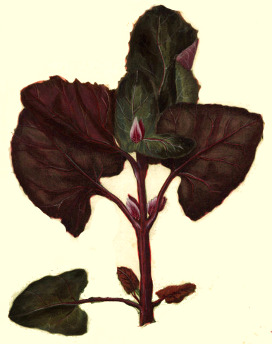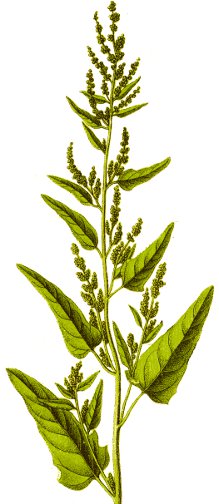 Atriplex
hortensis Atriplex
hortensisOrach
A leafy vegetable many of our ancestors
would have eaten, orach should have a place in any witch's garden.
An ingredient in the witch's friend, green salve, orach
is often eaten together with parsley, lovage, or sorrel, and
in Britain, orach was one of a number of plants (borage, burnet,
chicory, field mustard, lamb's lettuce, wood sorrel) that country
women once gathered in the wild to supplement their gardens.
Orach is a native of Western Asia and the Mediterranean that
became a popular veggie throughout Europe (introduced to England
in 1548) and later, in Africa and North America. It's more
robust than spinach. Baby leaves are good for salads; young
leaves make good cooked greens and can sub for spinach
in most recipes. The purple and red colors will flow into the
cooking water and color noodles or rice (these will turn your
green salve brown!). Orach is considered a Moon plant,
probably because it was once commonly found growing in sea marshes, and Culpeper said it had cold and moist qualities (and it is
one of those leafy greens that like lettuce, another Moon plant,
doesn't need any additional water to cook), but some consider
it Saturn because it likes to grow in disturbed ground and in
areas that other cultivated or tamer plants might not enjoy.
Also known as melde, meedle, milds (for "meal," from
the meal-like pollen), arrach, mountain spinach, arocche bonne-dame,
goosefoot, blite, butter leaves, French spinach, giant lambsquarters,
saltbush (because it can tolerate a certain amount of saltiness
and because it can have a slightly salty taste).
|
Atriplex hortensis
Moon
Herb © 2014-2024 Alchemy Works; No reproduction without permission. Ingredients in green salve: betony, rue, lovage, fennel, sage, stitchwort, savine (Juniperus sabina), tansy, comfrey roots, sclarea, marche, chervil, ravens foot (buttercup), mugwort, oregano, orache, pennyroyal, pimpernel, cinquefoil, valerian, burdock, meadowwort, turnsol (Heliotropum europaeum), bishopwort (wood betony - Stachy betonica), hazel, quince, hedgecliver (cleavers?), groundsel (Senecio vulgaris), brookmint (Mentha aquatica) and other mints, chicken "meat," sweet gale, hedge hop (dwarf variety of Humulus lupulus), costmary, earth navel or asparagus, leaves of nut beam (?), laurel berries, cumin, oil, and wax! - From "Leechdoms, Wortcunning, and Starcraft of Early England" by Oswald Cockayne (1866). |
 How to grow Orach
How to grow Orach